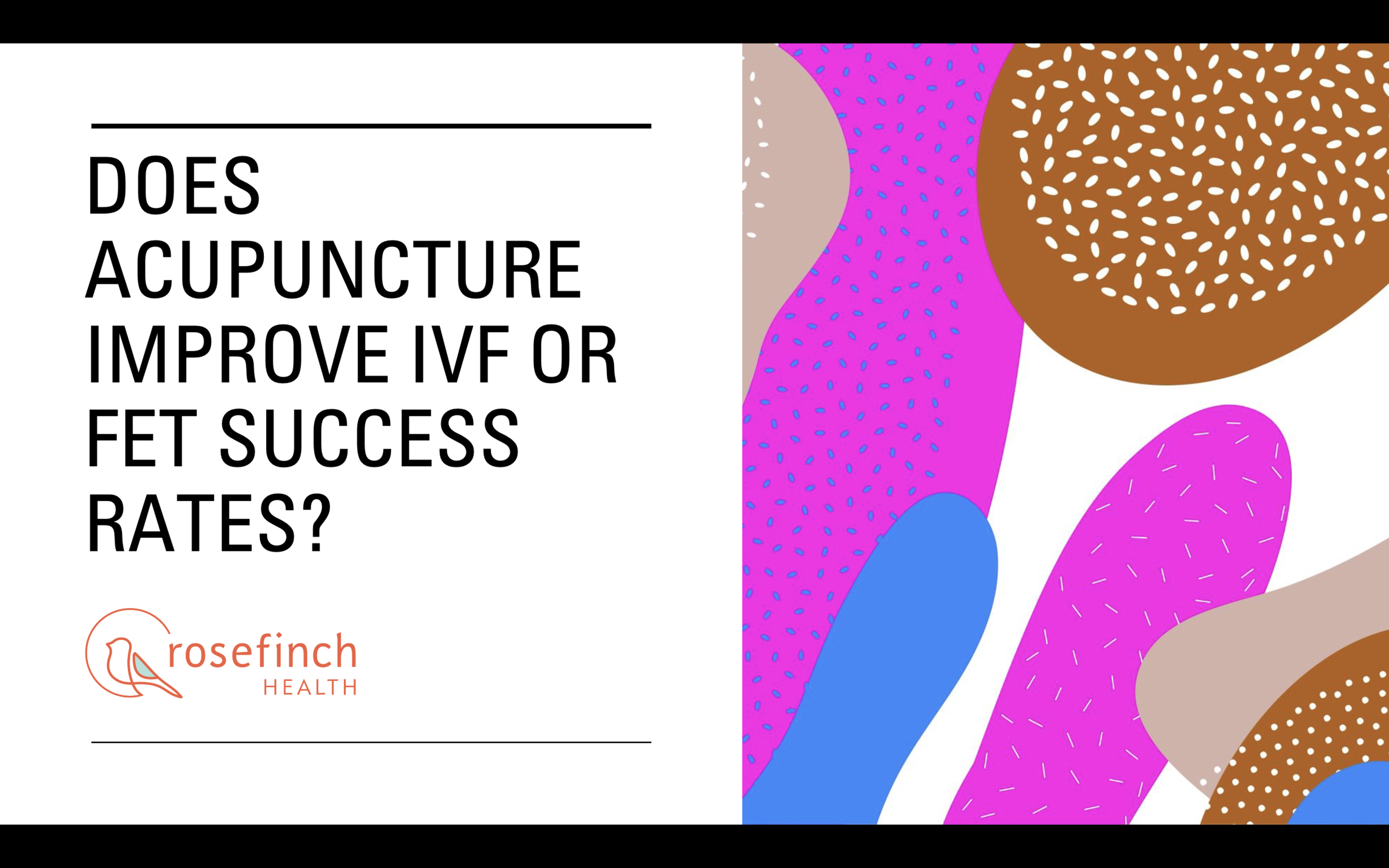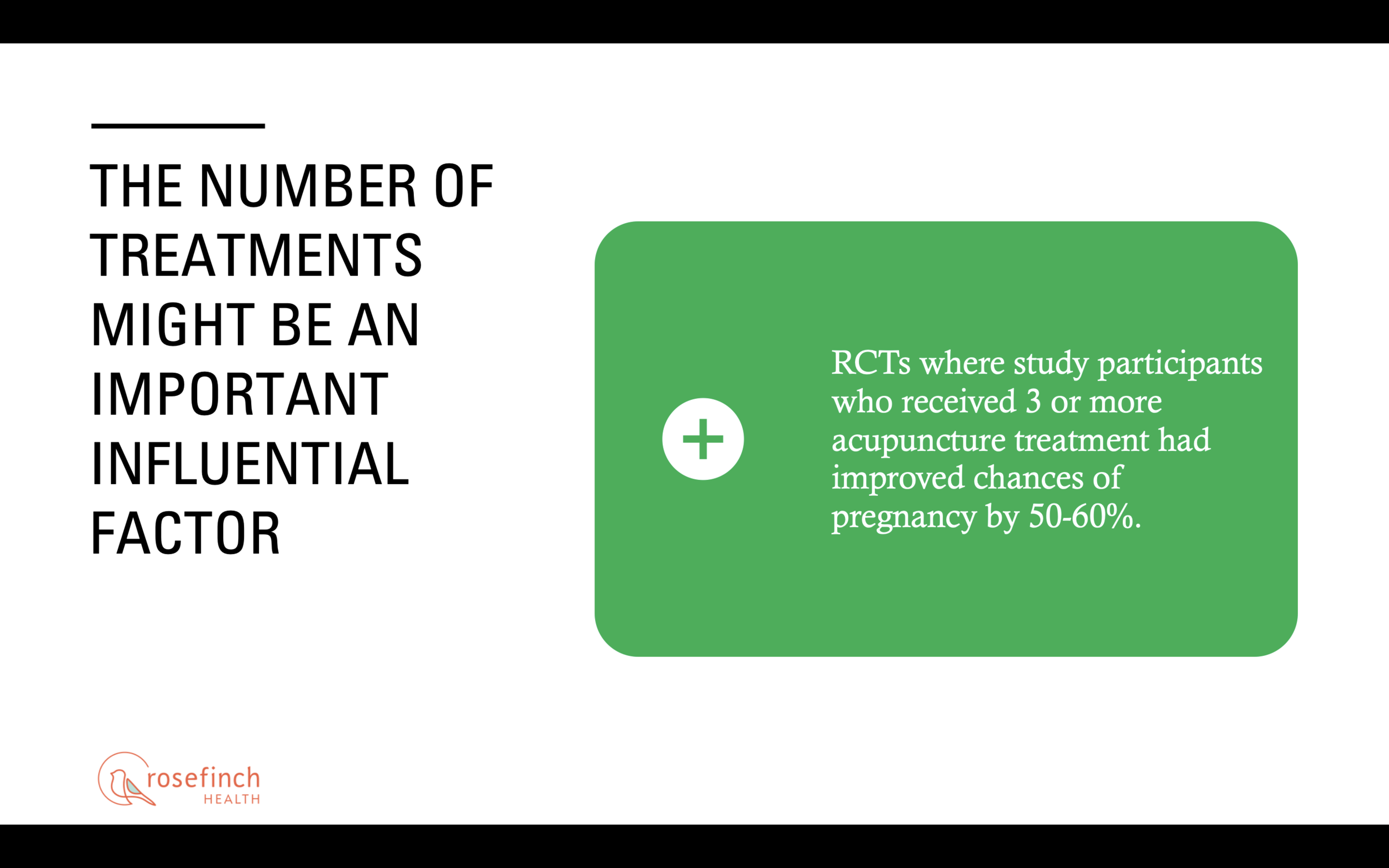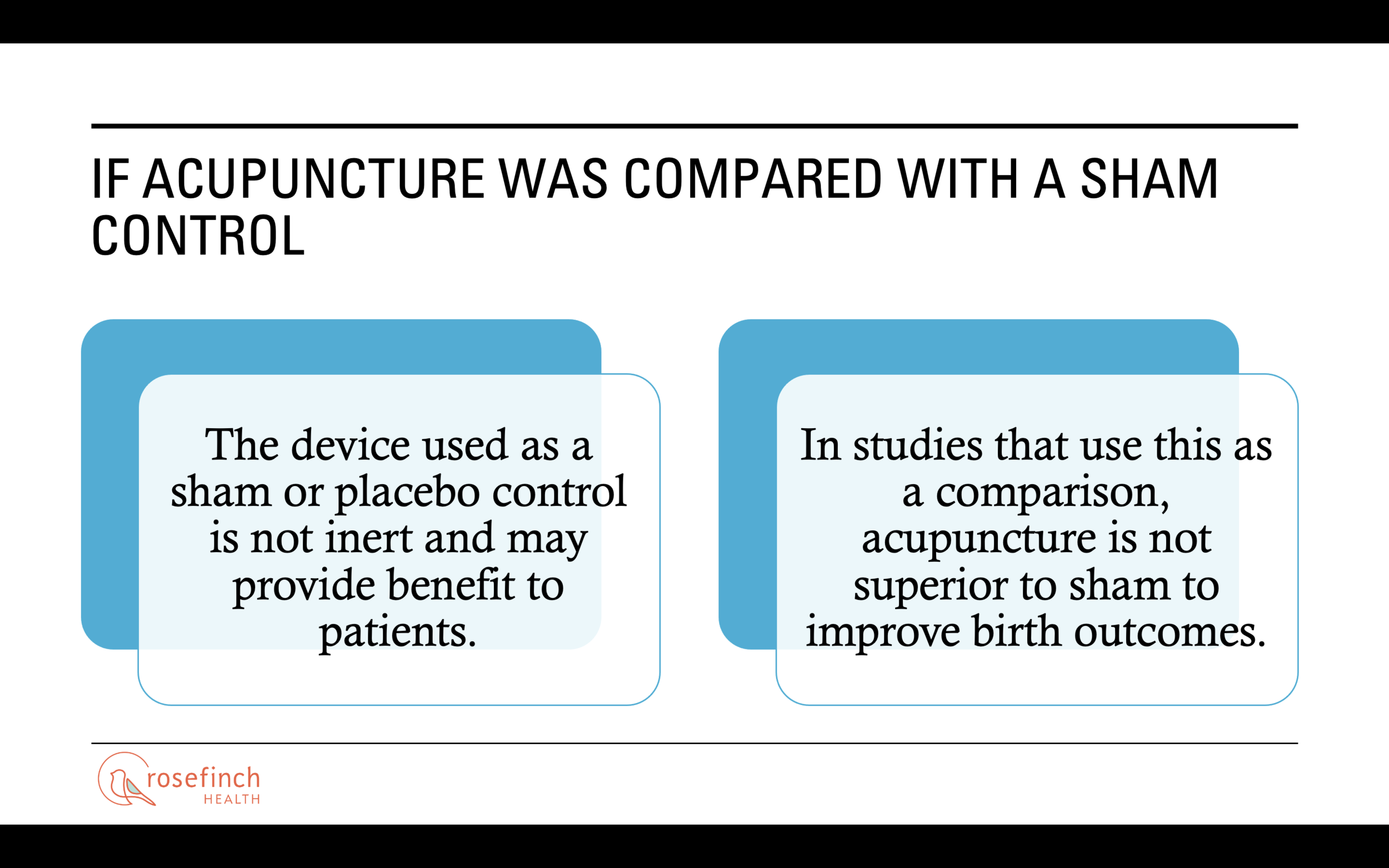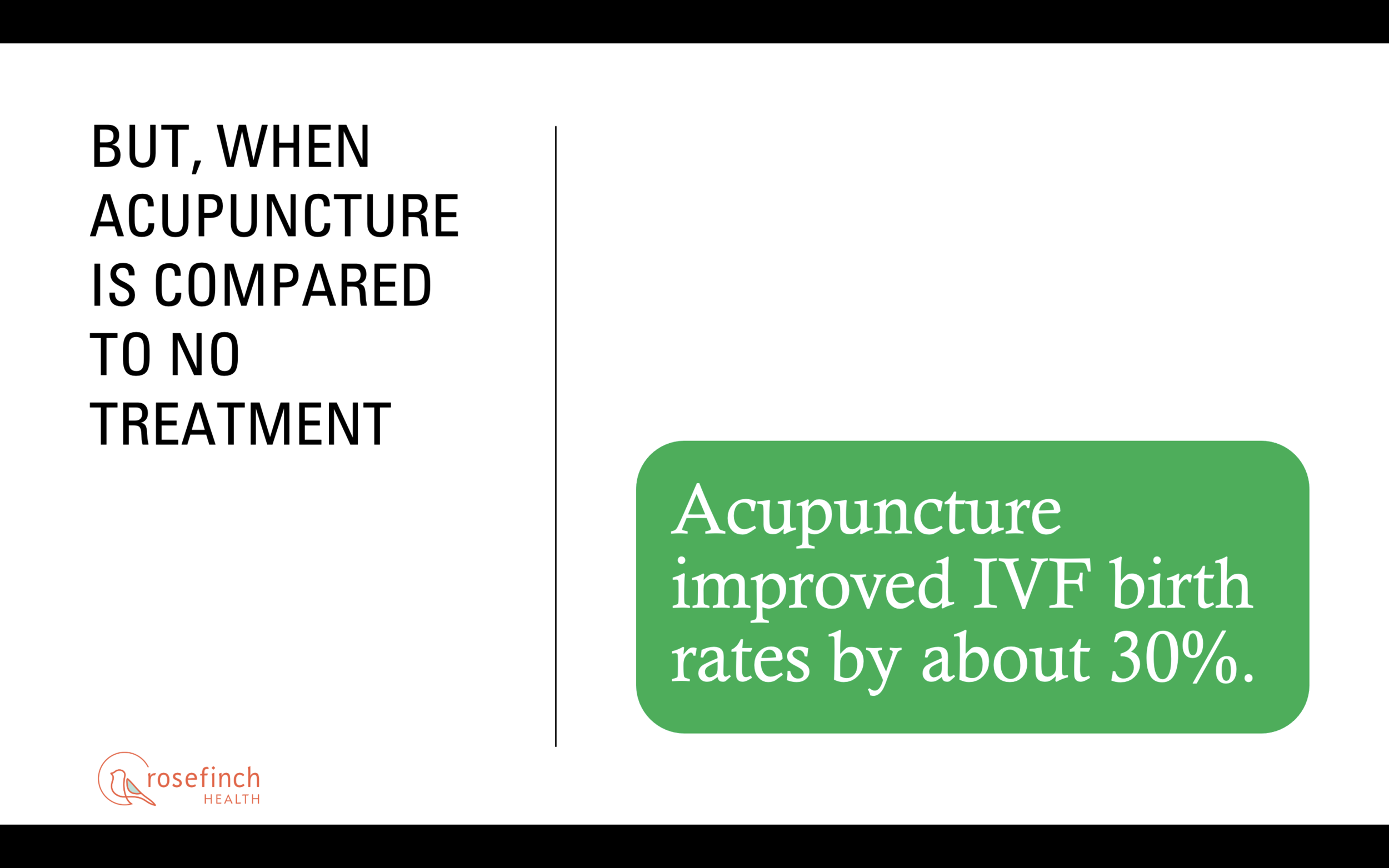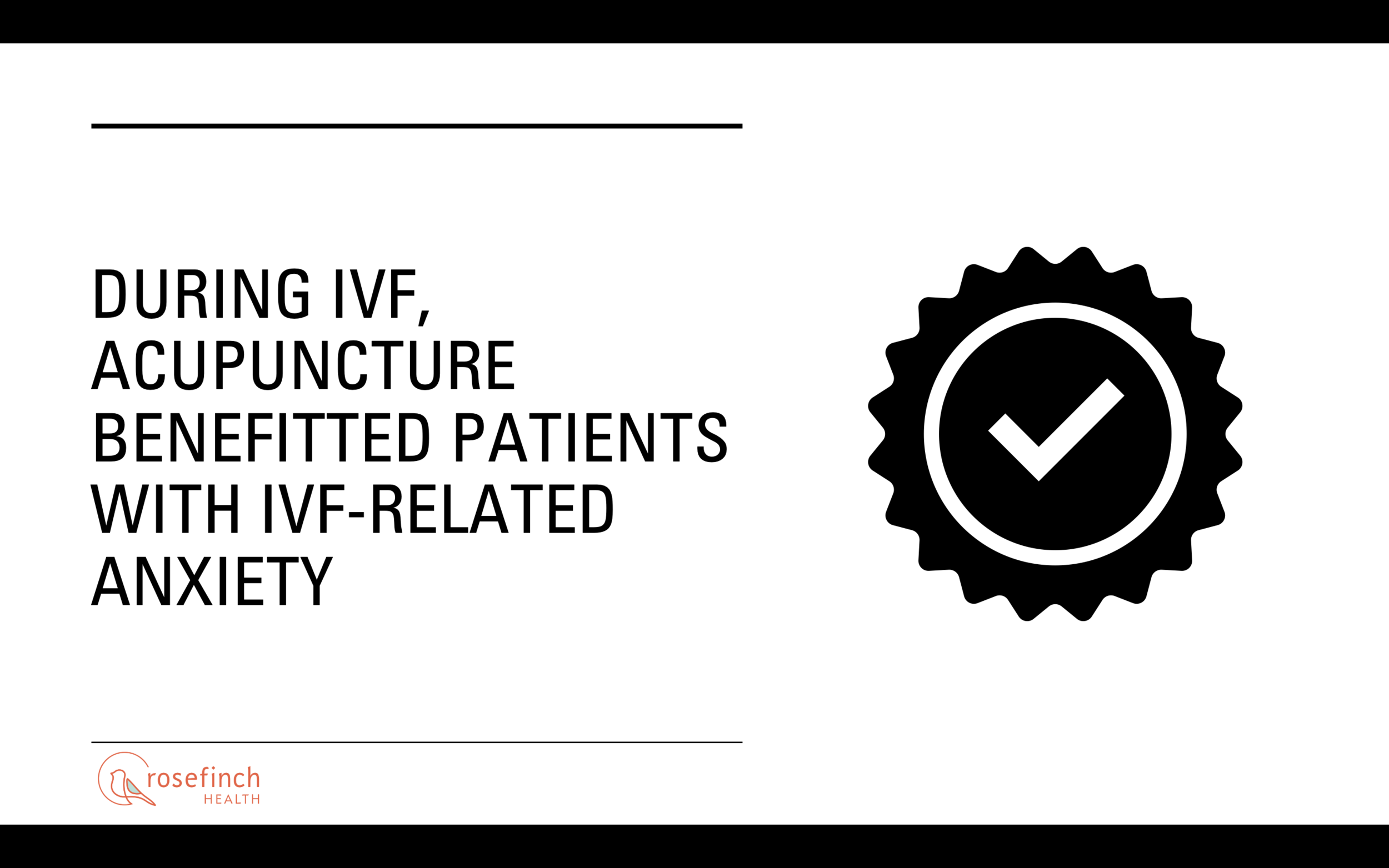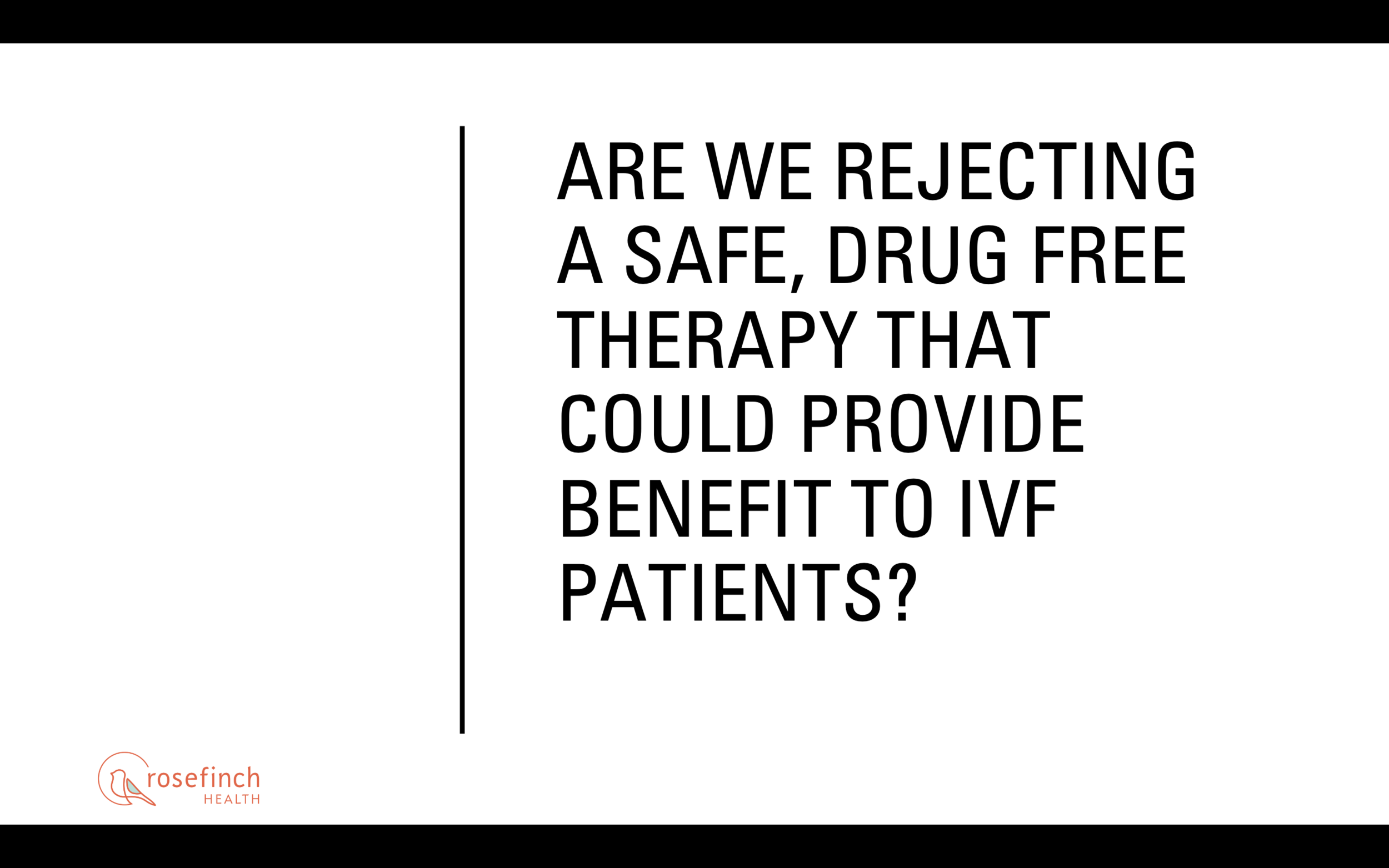Does acupuncture improve IVF success rates?
When trying to conceive, patients want to improve their chances of success. Many turn to acupuncture to support them during their IVF cycle. A reasonable question is: does acupuncture improve IVF success rates? Before I answer this full disclaimer, I am an acupuncturist and clinical researcher by training. I have published several studies on acupuncture as a treatment to support IVF patients. I've also written a couple of papers critiquing the research. It is my conclusion that the answer to whether acupuncture improves IVF outcomes boils down to two things:
1. the dose or number of acupuncture sessions attended during an IVF cycle, and
2. what acupuncture was compared with in a randomized, controlled trial (RCT).
When patients attend at least 6 acupuncture sessions (including two at embryo transfer), they may benefit from acupuncture to improve their chances of pregnancy and live births from:
• Fresh IVF with one’s own eggs[1]
• Fresh IVF with donor eggs [1]
• Frozen ETs with embryos that were not genetically tested [2]
• Frozen ETs with genetically screened normal embryos[3]
These were cycles where acupuncture was associated with better outcomes when compared with only two sessions on the day of embryo transfer [1-3] or no additional treatment at all. [1]. The limitations to this data are that these studies were not randomized, so the results observed are only associations of benefit. A follow up RCT is needed.
However, and here is where things get confusing, the data from RCTs usually looks at two sessions of acupuncture provided around the embryo transfer (immediately before and after). In that smaller “dose,” acupuncture added to IVF (fresh and frozen) improves the chances of live birth by about 30% when compared with no treatment. [4, 5] Still, there is no clinically meaningful improvement with acupuncture when compared with "sham" acupuncture. [4, 5] If taken on its face and applying the research method, one would naturally conclude acupuncture doesn't help because it is not superior to placebo. But, herein lies the paradox!
First, IVF success rates continue to improve year by year. The first studies of acupuncture added to IVF were when the baseline pregnancy rate was in the low 30% range. According to the latest CDC SART data, the national average is in the low 50% range, with some clinics' live birth rates in the mid-70% range. As an acupuncturist, I am not sure I would expect two stand-alone acupuncture sessions as a reasonable intervention to improve IVF success rates. One injection of gonadotropins is not enough to adequately stimulate one's ovaries; a series of injections over a short period is more effective. This is also true with acupuncture. It is not a one-and-done treatment. While one session was enough to improve markers of glucose metabolism in one study of women with PCOS,[6] a series of eight sessions over four weeks was needed to improve blood flow to the uterus.[7] Of note, acupuncture on the day of embryo transfer does appear to help reduce IVF-related anxiety.[8]
Second, sham acupuncture is intended to be a placebo – aka inert, nothing, nada, zilch, zip! Unfortunately, there is reasonable evidence demonstrating sham acupuncture is, in fact, not inert. One study found sham acupuncture's effectiveness was about 20% more than a typical placebo, aka sugar pill, used in research.[9]Another study found sham needling caused the body to release endorphins into the bloodstream to the same degree as real acupuncture. [10] These findings suggests that sham acupuncture is likely not inert and instead benefits study participants who receive it. In many of the trials using sham needles, study authors often refer to the possibility that the sham needles may not be inert.[11, 12]
If it is true that the sham provides benefit, and we don't see any difference between real and sham acupuncture. Still, we DO find a difference between real acupuncture and no treatment. Are we rejecting a potentially beneficial therapy in error? Why do we see robust differences in live birth rates between patients who attend more acupuncture compared with those who just do the day of embryo transfer acupuncture in observational research? It seems we are looking at the wrong dose of acupuncture and expecting two treatments to perform a miracle to improve birth outcomes.
We don't have a clear answer. We haven't yet figured out the best method to control for acupuncture in RCTs, but honestly, we aren't alone in this. Other areas of medicine face similar challenges. For example, what is a reasonable control method for a surgical procedure, a sham surgery? Can we ethically put a study participant under anesthesia, cut them open, perform a "sham" surgery, sew them back up, and look at who did better? And we aren't clear on the exact number of acupuncture sessions needed to improve IVF success rates. It seems like it is at least more than 3.[4] Finally, the evidence has not kept up with the current IVF practice. More and more cycles are FET cycles, not fresh IVF embryo transfers. Nearly all of the published acupuncture IVF trials were, save for one, done with fresh transfers.
While there are more questions than answers, here is what we know:
1. If we take the evidence on its face, two acupuncture sessions are not superior to a sham control to improve birth outcomes when provided on the day of embryo transfer. However, the sham control is likely not inert, so we may be inadvertently rejecting a treatment that could provide benefit.
2. When two acupuncture sessions are compared to no treatment, success rates (live birth) improve by 30%, and likely benefits patients with IVF-related anxiety.
3. More sessions of acupuncture may provide more benefits. When 9-12 sessions are added to an IVF cycle, acupuncture was associated with robust improvements in pregnancy and birth rates.
4. We don't have a lot of evidence on FETs yet. There is only one trial where acupuncture was compared with sham control. In that study, the sham control group performed better than the real acupuncture group. Again, sham needling is likely not inert.
5. The observational research suggests 6 sessions of acupuncture (including the day of embryo transfer acupuncture) are associated with more live births than just two acupuncture sessions at embryo transfer.
Reach out via the contact us page with any questions or comments about this post. We clearly need more well-designed research. Thanks for reading to the end!
References
1. Hullender Rubin, L.E., et al., Impact of whole systems traditional Chinese medicine on in vitro fertilization outcomes. Reproductive Biomedicine Online, 2015. 30(6): p. 602-612.
2. Rubin, L.H., et al., Birth outcomes from acupuncture added to frozen embryo transfer (fet) of autologous embryos without genetic screening: a retrospective cohort study. Fertility and Sterility, 2020. 114(3): p. e330.
3. Rubin, L.H., et al., Impact of acupuncture and traditional chinese medicine (TCM) on frozen embryo transfers (FET) of autologous embryos with comprehensive chromosomal screening (CCS): a retrospective cohort STUDY. Fertility and Sterility, 2020. 114(3): p. e450-e451.
4. Smith, C.A., et al., Acupuncture performed around the time of embryo transfer: a systematic review and meta-analysis. Reprod Biomed Online, 2019. 38(3): p. 364-379.
5. Xie, Z.Y., et al., The effects of acupuncture on pregnancy outcomes of in vitro fertilization: a systematic review and meta-analysis. BMC Complement Altern Med, 2019. 19(1): p. 131.
6. Benrick, A., et al., Autonomic nervous system activation mediates the increase in whole-body glucose uptake in response to electroacupuncture. FASEB, 2017. 31(8): p. 3288-3297.
7. Stener-Victorin, E., et al., Reduction of blood flow impedance in the uterine arteries of infertile women with electro-acupuncture. Human Reproduction, 1996. 11(6): p. 1314-7.
8. Chu, K., et al., A systematic review and meta-analysis of nonpharmacological adjuvant interventions for patients undergoing assisted reproductive technology treatment. International Journal of Gynecology & Obstetrics, 2017. 139(3): p. 268-277.
9. MacPherson, H., et al., Influence of control group on effect size in trials of acupuncture for chronic pain: a secondary analysis of an individual patient data meta-analysis. PLoS One, 2014. 9(4): p. e93739.
10. Harris, R.E., et al., Traditional Chinese acupuncture and placebo (sham) acupuncture are differentiated by their effects on mu-opiod receptors (MORs). Neuroimage, 2009. 47(3): p. 1077-1085.
11. So, E.W., et al., Acupuncture for frozen-thawed embryo transfer cycles: a double-blind randomized controlled trial. Reprod Biomed Online, 2010. 20(6): p. 814-21.
12. Smith, C., M. Coyle, and R.J. Norman, Influence of acupuncture stimulation on pregnancy rates for women undergoing embryo transfer. Fertil Steril, 2006. 85(5): p. 1352-8.


